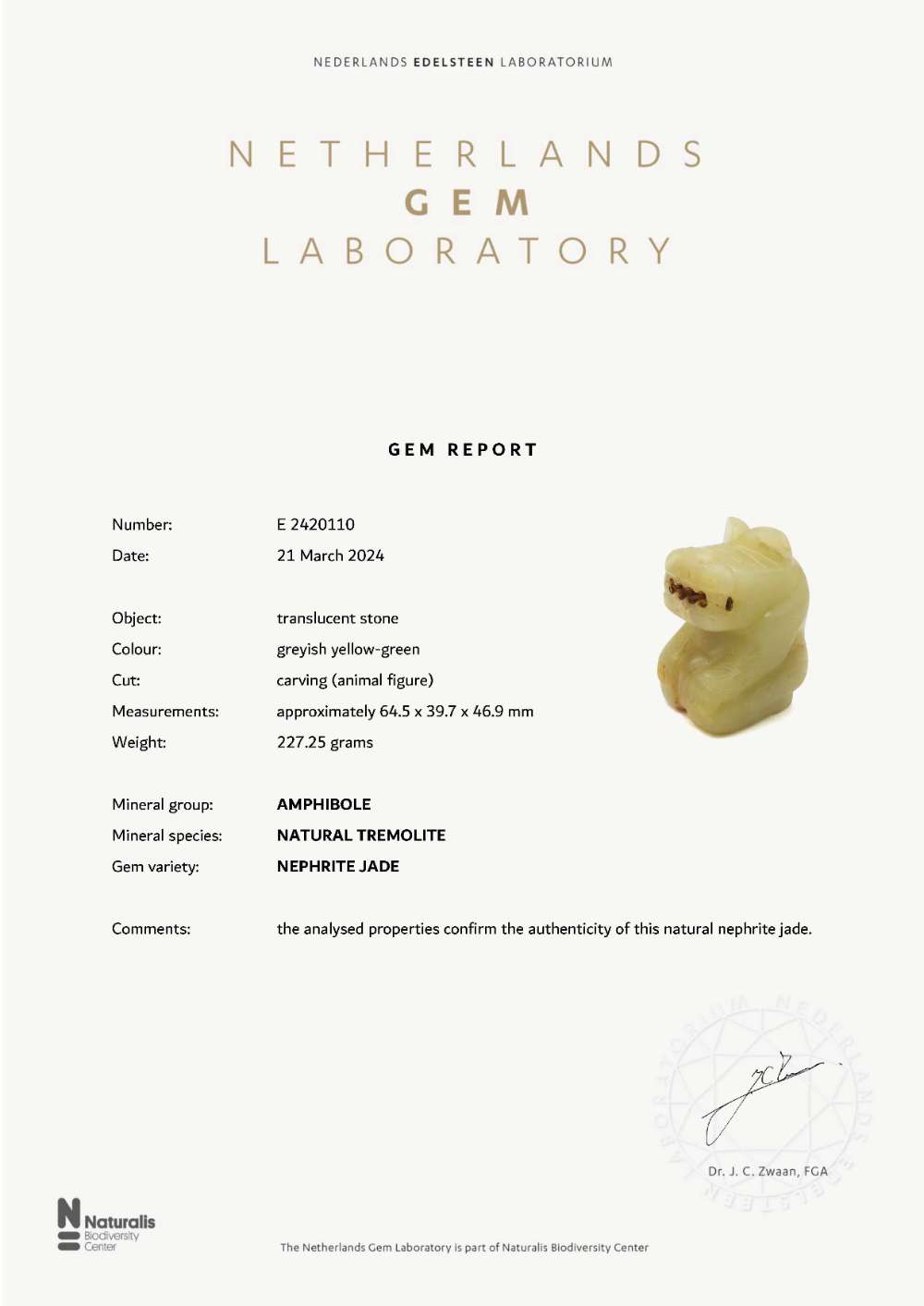


















An amazing nephrite jade kneeling bear pendant from Shang/western Zhou Dynasty, China
An amazing nephrite jade kneeling bear pendant from Shang/western Zhou Dynasty, China
- Country: China
- Period: Shang Dynasty / western Zhou (1750-771 BC)
- Mineral group: Amphibole
- Mineral species: Natural tremolite
- Gem variety: Nephrite jade
- Colour: greyish yellow-green
- Size: 64.5 x 39.7 x 46.9 mm
- Weight: 227.25 gram
- Extremely nice piece of art!
- This object has recently be tested by the Netherlands Gem Laboratory with the result that "the analysed properties confirm the authenticity of this natural nephraite jade".
- For more information about the Netherlands Gem Laboratory, follow link: https://www.naturalis.nl/en/science/netherlands-gem-laboratory
______________________________________________________________________________________________
The Zhou Dynasty (c. 1046–256 BCE) is a significant period in Chinese history, marked by substantial cultural, political, and social developments. It is traditionally divided into two distinct periods: the Western Zhou (c. 1046–771 BCE) and the Eastern Zhou (770–256 BCE), with the latter further divided into the Spring and Autumn period (770–476 BCE) and the Warring States period (475–221 BCE).
ESTABLISHMENT AND WESTERN ZHOU (C. 1046–771 BCE)
The Zhou Dynasty was established by King Wu of Zhou, who overthrew the last ruler of the Shang Dynasty, King Zhou, in the Battle of Muye. The Zhou rulers justified their conquest by invoking the "Mandate of Heaven," a doctrine that held that the right to rule was granted by the gods based on the ruler's virtue and ability to govern well. This concept became a central tenet of Chinese political philosophy and justified the rise and fall of dynasties.
The Western Zhou period is characterized by a feudal system, where the king allocated lands to his relatives and loyal nobles, who in turn governed these territories and provided military support to the king. This decentralized system allowed for local autonomy but also maintained a network of loyalty and service to the central authority.
CULTURAL AND TECHNOLOGICAL ADVANCEMENTS
The Zhou Dynasty saw significant advancements in agriculture, bronze casting, and the use of iron, which began to supplement and eventually replace bronze in tools and weapons. The development of the well-field system, a form of land redistribution and taxation, aimed to balance the interests of the state and peasantry, though its effectiveness and implementation varied.
Culturally, the Zhou period witnessed the compilation of key texts that became central to Chinese civilization, such as the "Book of Songs" (Shijing), the "Book of Documents" (Shujing), and the "Book of Changes" (Yijing). These works reflect the religious practices, historical records, and philosophical thought of the time.
EASTERN ZHOU: SPRING AND AUTUMN PERIOD (770–476 BCE)
The Eastern Zhou period began with the relocation of the capital to Luoyang after the fall of the Western Zhou capital, Haojing, to nomadic invaders. This period is marked by the fragmentation of Zhou authority and the rise of regional states that often acted independently of the Zhou king.
The Spring and Autumn period saw the emergence of influential philosophers and schools of thought, most notably Confucianism, founded by Confucius, and Daoism, attributed to Laozi. These philosophies addressed the political and social turmoil of the time and offered guidance on governance, ethics, and personal conduct.
WARRING STATES PERIOD (475–221 BCE)
The Warring States period was characterized by intense conflict and competition among the various regional states. The Zhou king's authority had become largely symbolic, with real power held by the leaders of these competing states. This period saw significant military innovations, including the use of iron weapons, cavalry, and large-scale infantry armies.
Despite the chaos, the Warring States period was also a time of intellectual and technological progress. The "Hundred Schools of Thought" flourished, producing ideas that would shape Chinese civilization for centuries. Additionally, improvements in agriculture, commerce, and statecraft laid the foundations for the eventual unification of China.
DECLINE AND LEGACY
The Zhou Dynasty officially ended in 256 BCE when the last Zhou king was deposed by the state of Qin. However, the dynasty's cultural and philosophical contributions endured, deeply influencing subsequent Chinese history and governance. The concept of the Mandate of Heaven, the feudal system's legacy, and the rich philosophical traditions of Confucianism and Daoism continued to shape Chinese society and government for millennia.
In summary, the Zhou Dynasty is a cornerstone of Chinese history, marked by significant developments in politics, culture, and philosophy. Its legacy is evident in the enduring principles that continued to influence China long after the dynasty's fall.
Please send an e-mail via below form, WhatsApp or call to order or get more information about this object.
We can communicate in English, Deutsch and Nederlands!
